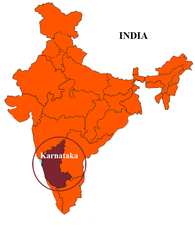
|
|
ISSUE NO. - 12, SEPTEMBER 2015
Impact of Malnutrition and Hunger
in Raichur District of Karnataka
in Raichur District of Karnataka
|
The Video testimony is from Raichur district,from the state of Karnataka, India, spells out the challenges of a family who has a severely malnourished child. The family with their meagre earnings have put all their resources towards the treatment of their child to ensure its survival.
About Karnatka
Karnatka is one of the southern states of Indian subcontinent. As per details from Census 2011, Karnataka has population of 6.11 Crores, an increase of 5.29 Crore in 2001 census. It shares its border with Maharashtra in North, Goa and Andhra Pradesh |
|
Tamilnadu and Kerala with South and Arabian Sea forms the western boundary. The total population of Karnatka is 61095297, out of that 30966657 is male and 30128640 is female with a sex ratio of 973. The total number of districts in Karnataka is 30. It occupies the seventh place in Human Development Index.
|
Malnutrition in Karnatka
Child malnutrition is the huge problem in Karnataka. Lack of nutrition food is the main cause of child malnutrition. Underweight, poor health growth these are the main symptoms of child malnutrition. Child malnutrition directly effects brain development. Malnutrition is a challenging problem for many districts in Karnataka such as Raichur, koppal, Bijapur, Bagalakot and Gulbarga. Malnutrition during infancy and early childhood is believed to have a long term impact on both physical growth and intellectual performance in later life. The Nutrition indicators of National Family Health Survey(NFHS) examines that there is a very little improvement in the Nutritional status of children in Karnataka. As per 2005-06 data of NFHS, the percentages of stunted, wasted and underweight children were 42.4%, 18.9% and 33.3% respectively, which was 41.9%, 25.1% and 38.6% in NFHS 1998-99. Yet, an issue of concern has been the lack of any significant decline of malnutrition indicators between NFHS 2 and NFHS 3 of Karnataka. Anaemia is much more widespread among children between 6 to 35 months than it was seven years ago at the time of NFHS-2. As per National Nutrition Monitoring Bureau, 94.5% children in age group of 6-9 years and 96.1% children in 10-13 years in India were suffering from mild, moderate and severe levels of malnutrition. |


